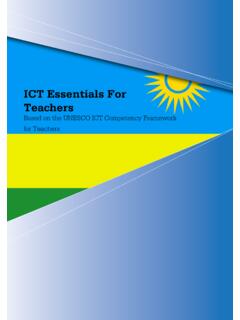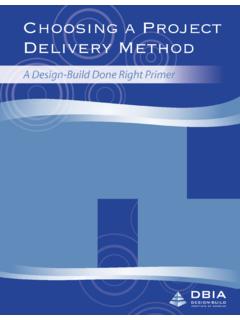Transcription of Review of human reliability assessment methods RR679
1 Executive Health and Safety Review of human reliability assessment methods Prepared by the Health and Safety Laboratory for the Health and Safety Executive 2009 RR679 Research Report Executive Health and Safety Review of human reliability assessment methods Julie Bell & Justin Holroyd Health and Safety Laboratory Harpur Hill Buxton Derbyshire SK17 9JN human reliability assessment (HRA) involves the use of qualitative and quantitative methods to assess the human contribution to risk. There are many and varied methods available for HRA, with some high hazard industries developing bespoke , industry focused methods . It was considered that it would be useful for HSE to be up to date with developments in the field of quantitative HRA methods and to have knowledge of the capability of the tools and an understanding of their strengths and weaknesses. Therefore, this project was commissioned to further HSE knowledge and expertise, and to form a view on the acceptability of the various tools for use in risk assessments.
2 This report and the work it describes were funded by the Health and Safety Executive (HSE). Its contents, including any opinions and/or conclusions expressed, are those of the authors alone and do not necessarily reflect HSE policy. HSE Books Crown copyright 2009 First published 2009 All rights reserved. No part of this publication may be reproduced, stored in a retrieval system, or transmitted in any form or by any means (electronic, mechanical, photocopying, recording or otherwise) without the prior written permission of the copyright owner. Applications for reproduction should be made in writing to: Licensing Division, Her Majesty s Stationery Office, St Clements House, 2-16 Colegate, Norwich NR3 1BQ or by e-mail to ii ACKNOWLEDGEMENTS The authors would like to thank their HSE colleagues Jane Bowie, Robert Miles and Martin Anderson for their comments on the use of HRA methods in HSE inspection and enforcement activity.
3 They would also like to thank the authors who provided additional information about the HRA tools they have developed, specifically Oliver Straeter and Eric Hollnagel. iii iv FOREWORD This document is an information resource on human reliability assessments (HRA) based on published research material and the opinion of the authors. It provides a summary of those tools and methods considered to be of potential use to analysts undertaking a HRA assessment in the major hazard sector. It is not intended to be a comprehensive guide to HRA but a useful starting point on which to build knowledge. There are other tools available that were not covered by this Review . v vi CONTENTS 1 1 Background .. 1 1 1 2 LITERATURE SEARCH .. 2 Methodology .. 2 Search Results .. 2 Tool summaries .. 2 3 SUMMARY OF THE HRA methods REVIEWED.
4 4 Summary of Tools considered useful to HSE major hazard directorates. 8 List of Tools considered not useful to HSE major hazard directorates .. 65 68 4 APPENDIX A .. 69 5 APPENDIX B .. 71 6 72 vii viii EXECUTIVE SUMMARY human reliability assessment (HRA) involves the use of qualitative and quantitative methods to assess the human contribution to risk. There are many and varied methods available for HRA, with some high hazard industries developing bespoke , industry focused methods . It was considered that it would be useful for HSE to be up to date with developments in the field of quantitative HRA methods and to have knowledge of the capability of the tools and an understanding of their strengths and weaknesses. Furthermore, there is potential that methods could be used out of context or inappropriately, and hence it is considered that HSE should form a view on the acceptability of such tools for use in risk assessments.
5 Objectives Undertake a Review of the literature to identify the range of qualitative and quantitative HRA techniques available and to carry out an assessment of their strengths and weaknesses. This will include simulation methods . Prepare a summary of the methods . Main Findings A total of 72 potential human reliability related tools and acronyms were identified within the search timeframe. Of these, 37 were excluded from any further investigation and 35 were identified as potentially relevant to HSE major hazard directorates and were investigated fully. Of the 35 potentially relevant HRA tools, 17 are considered to be of potential use to major hazards directorates. For each of these 17 methods , a brief summary was prepared that includes: What they claim to offer and how they work (their scope, approach and information on the underlying models of the methods ); The advantages and disadvantages of the method based on objective information available in the research literature; A comment on their potential application and major hazard sectors for which they would be suitable (if appropriate); A comment on their validity; and A note of the resources required for their use.
6 Each summary is based on the published literature, opinion and in some cases, personal communication with the authors of the methods . It should be noted that the published information, for many tools, provides an incomplete picture and therefore, there may be other information that has not been included in the reviews or the decision making process on the suitability of tools for HSE major hazard directorates. ix x 1 INTRODUCTION BACKGROUND human reliability assessment (HRA) involves the use of qualitative and quantitative methods to assess the human contribution to risk. There are many and varied methods available for HRA, with some high hazard industries developing bespoke , industry focused methods . It was considered that it would be useful for HSE to be up to date with developments in the field of quantitative HRA methods and to have knowledge of the capability of the tools and an understanding of their strengths and weaknesses.
7 In addition, the number of HRA specialists in HSE and HSL is extremely limited, and their knowledge is often restricted to one domain or tool. Therefore, this project was commissioned to further HSE knowledge and expertise, and improve consistency across major hazard directorates where appropriate. Furthermore, there is potential that methods could be used out of context or inappropriately, and hence it is considered that HSE should form a view on the acceptability of such tools for use in risk assessments. AIMS The aims of this project are: To provide HSE with a Review of the HRA literature; To form a view on the suitability of such tools for application in the major hazard sector, and to provide information for duty holders via the HSE human factors (HF) WebPages.
8 OBJECTIVES Undertake a Review of the literature to identify the range of qualitative and quantitative HRA techniques available and to carry out an assessment of their strengths and weaknesses. This will include simulation methods . Prepare a summary of the methods . This report provides an overview of the literature Review that was undertaken by HSL in response to HSE s knowledge requirement. It provides a summary of each of the most relevant HRA tools identified. 1 2 LITERATURE SEARCH METHODOLOGY A literature search was undertaken to identify published sources of information regarding qualitative and quantitative HRA methods , including simulation studies and, particularly, any Review papers. HRA specialists in HSL/ HSE provided many relevant papers and other information resources such as the Internet were searched by the HSL project team.
9 In addition, a search was commissioned from the HSE Information Centre where a team of Information Specialists searched for appropriate papers from a range of databases, using search terms specified by the project team. The search was designed to collate source papers that detailed HRA methods , and subsequent validation and Review papers. The aim of the literature Review was to draw upon knowledge from existing published reviews, and not necessarily to assess each tool from source references. A time limit of one month was placed on the literature search period because it was recognised that the main tools would be identified within that timeframe, and prolonged searching would provide diminishing returns. SEARCH RESULTS A total of 72 potential human reliability related tools and acronyms were identified within the search timeframe.
10 After reading the details of these 72 results, 37 were excluded from any further investigation and 35 were identified as potentially relevant to HSE major hazard directorates and were investigated fully. The decision to exclude 37 was based on a high level assessment of the available information to determine the likelihood of applicability to HSE major hazard directorates. A more detailed analysis of the tools might have resulted in more being selected as potentially relevant but this was not possible within the scope of the work. The reasons for exclusion included; the acronym related to a tool for managing crew numbers, aviation specific tools, human computer interaction methods , human reliability databases, a programme of risk assessment models rather than a specific tool ( ASP, accident sequence precursor) or human error identification tools, all of which are outside the scope of the current work (refer to Appendix A for the list of 37 tools and the reasons for their exclusion).













